Architecture
![]()
The title of this article is ambiguous. For other meanings, see Architecture (disambiguation).
![]()
This article or subsequent section is not sufficiently supported by evidence (e.g., anecdotal evidence). Information without sufficient evidence may be removed in the near future. Please help Wikipedia by researching the information and adding good supporting evidence.
The word architecture (from Latin architectura 'art of building'; this from Ancient Greek ἀρχιτεκτονία architektonía with the same meaning) denotes in the broadest sense the craft occupation and aesthetic engagement of man with built space. Planned designing, shaping and constructing of buildings is the central content of architecture. There is a multitude of definitions of the term, which ascribe different tasks, contents and meanings to architecture. Some of them are presented below.
Vitruvius already spoke of the "mother of all arts", by which may be meant both the chronological sequence and the ranking of architecture in relation to sculpture and painting. In the classical understanding since Vitruvius' De Architectura, architecture is based on the three principles of stability (firmitas), usefulness (utilitas) and grace/beauty (venustas).

Master builder in the Middle Ages
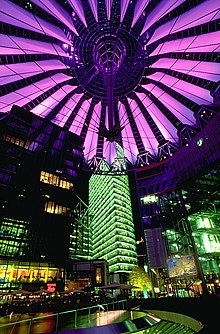
Postmodern architecture: Sony Center in Berlin, completed in 2000

Traditional architecture: Himeji-jō in Japan from the 17th century
Designation
Word origin
The word architecture is the Germanized version of the Latin architectura 'building art', which derives from the Greek ἀρχιτέκτων architékton. The latter is composed of αρχι- archi-, German 'Haupt-' and τέκτων tékton, German 'Baumeister' or 'Zimmermann' and could thus be translated roughly as 'chief craftsman' or 'chief builder'. The definition of what architecture is today thus also depends on the architect's field of activity. The term has changed again and again in the course of history and can only be grasped in its full depth historically.
Definition of the term
In the narrower sense of the classical concept of architecture, architecture means the science and art of the planned design of the built human environment, i.e. the examination of man-made space and in particular the interrelationship between man, space and time. In this context, the classical concept of architecture includes various facets of meaning. It stands
- for the art of building, the creation and aesthetic design of buildings / structural facilities of all kinds. However, the term architecture is no longer very sharp today. In an extension of the term, the term architecture today often stands in academic discourse for the art of creating and designing spaces in general. For Le Corbusier, the "art of building [...] is the knowing, precise, and magnificent play of building bodies under the light."
- as titles of building typologies,
- as a designation for the professional field of the architect,
- as a generic term for the works of architects.
- as a term for the science of building.
For centuries, architecture was understood in the broadest sense as building of any kind. Architecture was the design of buildings, the art of building, hence the term Baukunst. Architecture deals with individual buildings, mainly in the field of structural engineering. The list of buildings by function gives an overview of the diversity of tasks.
On a larger scale, urban design deals with the design of cities and large building complexes and the interaction between buildings and their surroundings.
Landscape architecture deals with the designed landscape and green spaces from an architectural point of view.
Interior design aims at the design of interior spaces.
However, this definition has been disputed, especially since the beginning of the 20th century. Accordingly, most attempts at definition only become comprehensible in the context of certain debates about the content, task and meaning of architecture, whereby the respective contemporary building with its aesthetic, technical, economic and political implications must also be taken into account. Similar to the concept of the work of art, it does not seem possible with the concept of architecture to limit oneself to the mere description of a word or a thing.
On closer examination, any more differentiated definition of the term proves to be a struggle for definitional sovereignty and power of validity. Due to the normative aspect implied in this way, any "content-related" definition of architecture remains controversial and is essentially ideological. Any attempt at definition - insofar as it contains a reflection - is already architectural theory. The definition of architecture is essentially based on the respective attitude and value system of the defining person, be it builder, architect or architectural theorist.
The fact that the assessments of the respective works of architects are usually controversial is unavoidable, since it is not only a competition of talent and competence, but also of the validity of individual value systems. Due to the variance of architectural views, there is a great wealth of forms in architecture today.
Classic architecture
According to Vitruvius (De Architectura), architecture is based on three principles: Stability (Firmitas), Usefulness (Utilitas) and Grace/Beauty (Venustas). All three categories must be given equal and equal consideration. On the one hand, they should determine the architectural design, on the other hand, they should serve as criteria for the evaluation of the finished buildings.
In addition, Vitruvius defines six basic concepts of architecture: "ordinatio", "dispositio", "eurythmia", "symmetria", "decor" and "distributio".
"Ordinatio", "eurythmia" and "symmetria" refer to the proportioning of the building. "Ordinatio" stands for the "dimensional order", i.e. the appropriate dimensional division of the members of a building, "eurythmia" for the graceful appearance and the dimensional appearance in the assembly of the building members and "symmetria" for the harmony of the individual elements with each other. In the first chapter of Book 3, in which Vitruvius explains the idealized proportions of the human body, the tracing of its dimensions back to basic geometric forms such as the square and the circle, as well as the modular foundations of the number systems, these statements on proportion are further elaborated.
"Dispositio" refers to the conception or disposition of the building and the building plans necessary for it, which he sets out with ground plan, section and perspective view ("ichnographia", "orthographia" and "scaenographia").
"Decor" refers to the flawless appearance of a building according to the rules of accepted conventions. As examples Vitruvius mentions, among other things, the correct assignment of column types (Doric, Ionic, Corinthian) to certain deities in temple construction, the coordination of exterior and interior, of stylistic sub-elements to the overall style, of rooms to cardinal points etc.
"Distributio" means, on the one hand, the appropriate distribution of building materials and expenses for construction, and on the other hand, the method of construction appropriate to the respective inhabitants.
The classical order of columns introduced by Vitruvius is still used in architecture today.
Distinction from general construction
Architecture as art has an effect through its special design quality and thus differs from general building (see also aesthetics).
The idea of what constitutes the actual architectural achievement in the design and production of a building, and what elevates the building above the purely functional, has changed significantly in the course of the past century: Until the end of the 19th century, it was primarily the use of traditional building forms (style) with often ornamental embellishments in which the artistic rank manifested itself as the added value and beauty of a building in conscious opposition to a pragmatism.
With the functionalism of the 20th century, a concept of architecture initially became predominant that gave priority to the purpose of buildings (including engineering structures). In the process, the constructive, proportion-giving and space-creating aspects of building became the design theme of architecture. At the same time, through numerous representations of modernity, progressiveness and the expression of the respective present, a primacy of functionalist architecture was sought. This functionalist understanding of architecture was loosened up in movements such as postmodernism and deconstructivism.
Quotes:
- "It has usually been assumed that a building only begins to be a work of art when it does more than merely satisfy a need. "(Hermann Muthesius: 1908 on the 19th century concept of architecture in: The Unity of Architecture)
- "The catchphrase "the functional is also beautiful" is only half true. When do we call a human face beautiful? The parts of any face serve a purpose, but only when they are perfect in form, color, and well-balanced harmony does the face deserve the honorary title of "beautiful." The same is true of architecture. Only perfect harmony in the technical purpose function as well as in the proportions of the forms can produce beauty. And that is what makes our task so many-sided and complicated." (Walter Gropius: 1955 in: Architecture)
- "Architecture, no matter how mundane or sophisticated the purpose it serves, is ultimately the totality of the environment altered by human hands and thus a cultural achievement of human beings." (Meinhard von Gerkan: 1982 in: The Responsibility of the Architect)
Spatial formation
Architecture can be defined by its space-creating character. From this point of view, architecture consists in the duality of space and shell. Architecture creates a boundary between outside and inside. This boundary or envelope creates an interior space and an exterior space (e.g. urban space) for the purpose of movement, residence and activity of people.
Further definitions
- Architecture is "harmony and unison of all parts, achieved in such a way that nothing could be taken away, added to, or changed without destroying the whole." (Leon Battista Alberti: 1452 in: De re aedificatoria)
- Architecture is, according to Louis Sullivan (1896), "the law of all things organic and inorganic, of all things physical and metaphysical, of all things human and superhuman, of all genuine manifestations of the head, the heart, and the soul, that life is recognizable in its expression, that form always follows function." (see also: form follows function)
- "Architecture today is created according to economic, constructive and functional laws. We are in a tough battle with reality. And when something similar to what is called art is added to this, then one can speak of improbable luck in one's life." (Egon Eiermann: Great Architects. HäuserBuch-Verlag)
- "Architecture combines art and science (or technology) to order the environment according to human needs" (Louis Hellman).
- "Architecture is knowledge of technique, receptivity to the artistic side of the matter." (Arne Jacobsen)
- "The elementary expression of architectural forms is a gestural one. It is based, on the one hand, on the qualities of the built things, and on the other hand, on the sensations of the feeling, moving body." (Wolfgang Meisenheimer: The Thinking of the Body and Architectural Space)
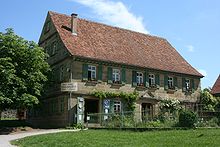
Where does architecture begin and "mere building" end?
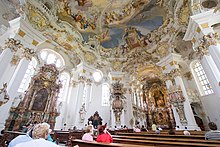
Baroque architecture (Wieskirche)
_-_Hofpavillon_(2).JPG)
Art Nouveau architecture: Hofpavillon Hietzing in Vienna from 1898, architect Otto Wagner
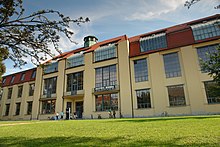
Main building of the Bauhaus University Weimar (1904-1911 according to designs by Henry van de Velde)

In the case of Mies van der Rohe's Barcelona Pavilion, one speaks of "flowing" space
_-_facade_on_Piazza_dei_signori.jpg)
The Basilica Palladiana in Vicenza by Andrea Palladio. Renaissance architecture transmitted and continued classical principles of antiquity.
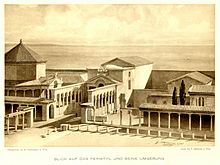
Section through Diocletian's Palace, c. 300 A.D. George Niemann, 1906
.jpg)
The St. Gallen monastery plan is a famous medieval architectural drawing
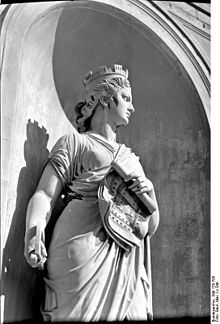
The art of building . Figure at the Orangery Palace (Potsdam)
Architectural History
→ Main article: History of architecture and history of architecture
The history of architecture is as old as the history of mankind and closely interwoven with it as a cultural element. In accordance with this great importance, two terms are encyclopedically separated: a chronological overview of the individual developmental steps can be found under the headings History of Architecture and Architectural Style, respectively, while explanations of the methodology and field of the subject can be found in the article History of Architecture. The subject of architectural history is the part of cultural studies that deals with the historical dimension of architecture using primarily art-scientific and, secondarily, engineering-scientific and sociological methodology.
Museums
Large architecture museums can be found in Berlin Architekturmuseum der TU Berlin, Frankfurt (Deutsches Architekturmuseum) and Munich (Architekturmuseum der TU München).
See also: Architecture Centre and Federation of German-Speaking Architecture Collections
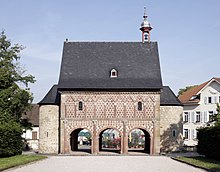
Lorsch gate hall from the 9th century
Questions and Answers
Q: What is architecture?
A: Architecture is the design of buildings and structures, using both art and engineering.
Q: What are some examples of types of buildings that can be designed by architects?
A: Examples include houses, churches, hotels, office buildings, roads, viaducts, tunnels, and bridges.
Q: What is the profession of an architect?
A: The profession of an architect involves designing buildings and structures.
Q: What type of education is required to become an architect?
A: Usually, a person must study at an institution of higher education (university) to become an architect.
Q: How did architects learn before higher education?
A: Architects learned by being an apprentice to an established architect.
Q: Can architects design only small or large projects?
A: Architects can design both small projects, such as a garage, or large projects, such as a whole city.
Q: Does architecture overlap with other fields?
A: Architecture often overlaps with structural engineering, and architects and engineers often work together.
Search within the encyclopedia